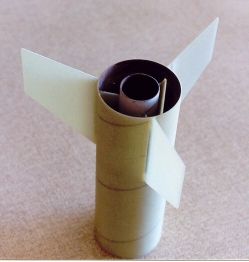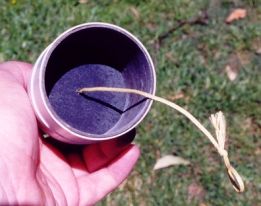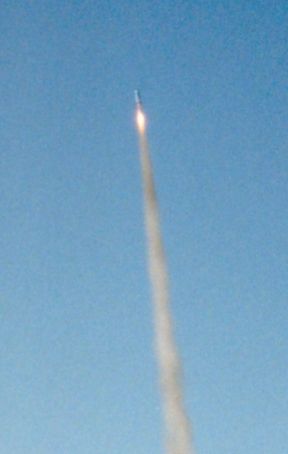Modification Fat Boy - 29mm Modification
Modification - Fat Boy - 29mm {Modification}
Contributed by Scott McLeod
| Manufacturer: | Modification |
 Brief:
Brief:
An Estes FatBoy modified with a glassed body tube, 29mm MMT and G10 fins for F, G, and H motors. External dimensions are stock. Best "bang-for-buck" rocket that I ever built.
Modifications:
When glassing the tube, I used a long section of PML 2.6" coupler tube wrapped in greaseproof paper to provide some support as the Estes tube is very thin. The greaseproof paper released nicely with only minor stickups at the fin slots which sanded away easily. The fins were cut using a jigsaw with a fine-tooth metal cutting blade. The teeth have a set similar to a hacksaw and work just fine on G10. [NOTE: Use a wood cutting blade and you'll regret it--they wear out almost instantly on G10.] Construction sequence was pretty normal for an HPR capable rocket: forward CR epoxied to the MMT, Shock cord mount epoxied to the MMT, epoxy MMT assembly into the body tube at the front ring only. The rear ring is just there to locate the motor tube and can be removed by means of clear tape tabs like PML tell you to do. After epoxying the fins to the motor tube, the rear ring is removed and internal filleting is done, then the rear ring is epoxied on and external fin fillets are done. Except for the glassing, all assembly used 5-minute epoxy. The body and motor tube ends were CA'd for durability.
 Construction:
Construction:
The stock 8" Estes body tube was glassed with 3 layers of 4oz crowsfoot glass in West Systems epoxy. This was probably excessive; I'm sure 2 layers would have been fine. I used the stock balsa fins as a pattern and cut new ones from 1/16" G10. The stock nosecone was modified by cutting off the base to leave 1.375" of the shoulder, and then reinforced internally with a 2.5" long mailing tube sleeve and a cut-down Aerotech bulkhead. The hole in the AT bulkhead was used to pass through a short length of heavy Kevlar thread with a loop tied in the aft end to attach the shock cord (6' of 1/2" flat elastic) and epoxied to the front (top) side of the bulkhead, where I also added a large steel washer to provide 1.5oz of nose weight (more than enough for such a stubby rocket). The chute now resides in the compartment formed in the nosecone, and is attached to the forward end of the shock cord with a 1/8" quick-link to make disassembly for cleaning (and z-folding the elastic) easier. I used a 10" AT chute and a small Nomex flame shield. The 5" long motor mount tube and centering rings were Aerotech parts; the AT centering rings are a perfect fit in the Estes tube, and the shock cord mount for the airframe used a short length of 1/8" Kevlar epoxied to the motor mount tube and passing through the notch in the top CR that normally clears the AT motor retaining clip. I used a 4" length of LOC 1/4" launch lug. No motor retention is provided except for friction fitting and taping the motor thrust ring to the exposed length of the MMT which was CA'd for extra durability. I did not attempt to blend the step in the diameters of the glassed BT and the stock nosecone.
 All parts were present and accounted for but as you can see I didn't need many of them. This would be a very easy kit to build stock as everything fit well and the instructions are excellent. The balsa fin stock was of good quality and I am sure it would be good if you were planning on a 24mm MMT but I felt that something sturdier was in order. As usual the stock shock cord was way too short and of questionable quality even for a stocker. I used 1/2" flat elastic as you can fit a lot of it in a small space and for a rocket in this weight class is entirely adequate so long as you check it before each flight for damage.
All parts were present and accounted for but as you can see I didn't need many of them. This would be a very easy kit to build stock as everything fit well and the instructions are excellent. The balsa fin stock was of good quality and I am sure it would be good if you were planning on a 24mm MMT but I felt that something sturdier was in order. As usual the stock shock cord was way too short and of questionable quality even for a stocker. I used 1/2" flat elastic as you can fit a lot of it in a small space and for a rocket in this weight class is entirely adequate so long as you check it before each flight for damage.
Finishing:
The decals are excellent and really finished the rocket off nicely. There was a fair bit of head scratching over a color scheme as I wanted something different from stock that would also suit the decals. I ended up using Holts Dupli-Color auto repair spray cans in Toyota Derwent Blue for the body/fins and Holden Cyan for the nosecone, both over matching sandable primer. These are both metallic so I clear coated the entire rocket before applying the decals and was very pleased with the results.
 Flight:
Flight:
The first flight used a 24mm E15-7 (in an adapter) as this simmed reasonably well... except for the infamous chuffing which didn't seem to leave much in the way of impulse once it finally left the pad. Consequently the flight was very low and the ejection occurred about 20' off the ground (actually below ground level as the pads at this site are on a hill). I fully expected it to be trashed despite seeing the chute pop open immediately before impact but the FatBoy was unmarked!
The second flight used a G64-10 and it absolutely ripped off the pad at nearly 20g. Ejection was right at apogee (though it was kind of hard to see so far up!) and once again recovered without a scratch. Unlike the E powered flight, this one was extremely straight. On G and H motors it is best to use the shortest launch rod possible (I used half of an Aerotech 2-piece rod) to minimize whip, which can be a big problem on rockets of this diameter on a 1/4" rod.
 Third flight was on a G80-10 for about 25g and the same perfect recovery.
Third flight was on a G80-10 for about 25g and the same perfect recovery.
The fourth flight used an H128-14. With RockSim indicating just over 30g and almost 4000ft, this flight was awesome (see photo)! That baby H motor sounded fantastic as the Doppler shift really deepens the scream into more of a "whoom!" imitating a much larger motor. I had to walk a bit further but once again, a perfect recovery.
Recovery:
The original shock cord is undamaged and I have removed and washed the flame shield a couple of times as it gets kind of cruddy being jammed right against the ejection charge. To use the H180/220 the chute will have to be wrapped around the motor as there is only about 1/8" left between the forward closure and the nosecone bulkhead. This should be interesting!
Summary:
What a great rocket! The stock kit is one of Estes' best ever designs and it has so much potential for modifications. It's hard to imagine a better kit to bash into something extreme than a Fat Boy. There are really no CON's with this rocket except that it could do with a 24mm MMT stock, and in modified form the chute is a pretty tight pack. (Whaddaya expect?!) I am completely satisfied with my modified version; had I suspected it would be this much fun I would have built it with a 38mm motor mount for even more versatility. I was already L3 when I flew the Fat Boy on an H, but I think it would be extremely cool to cert L1 & 2 on modified Estes rockets.
After the success of the 29mm version I naturally started thinking bigger. A 54/852 case will just fit if you wanted to go that extreme... However I decided to build something easier and am currently working on a 54mm Big Daddy built along the same lines as the Fat Boy (glassed, G10 fins, chute in the nosecone).
Other:
Short fat rockets do not need or want anywhere near as much static margin as more "normal" designs (See Robert Galejs' excellent article "What Barrowman Left Out" in May/June '99 Sport Rocketry on this subject) as the CP barely moves even at high angles of attack. Even with only 0.37 caliber (RockSim) it flies arrow straight. So don't get carried away with nose weight!
#Related Reviews
- 2 Fat By Geof Givens
Brief: After a spell of creative scratch rocket projects, all my fun ideas seemed to have dried up. Looking around the workshop, I smiled at good old Fat Boy: both my kids and my favorite rocket. He's always good for an exciting flight and safe recovery. Why not court disaster by trying to improve ...
- Excelsior Rocketry Der Fat Max By Bill Eichelberger
I always loved the versatility of the Estes Fat Boy, and over the years I bought quite a few of them for different projects, most of them of the Goony persuasion. When a fellow club member decide to move away from low power and offered one for sale from his stash, I jumped at the ...
- Fat Boy to AttaBoy Modification By Tad Scheeler
The ATTABOY is a boattailed FATBOY with 24mm upsized motor mount that can be flown in two different configurations--both with and without upper payload tube. Modifications: I was inspired by Michael Bade's " Big Bad V-2 Daddy ", Kevin Johnson's " OY!FATBOY ", and David Fergus' " Boattail FATBOY ...
- Modification 24mm Fat Boy By Morgan Hendry
This project began when I read several posts from rec.model.rockets on placing a 24mm motor mount in a Fat Boy, normally a 18mm kit. I first looked at the instructions and made a list of what I needed to do. Replace the 18mm motor tube with a 24mm one Make bigger motor mount with modified ...
- Modification Fat Boy - 24mm By Morgan Hendry
This project begun when I read several posts from rec.model.rockets on placing a 24mm motor mount in a Fat Boy, normally a 18mm kit. I first looked at the instructions and made a list of what I needed to do. Replace the 18mm motor tube with a 24mm one Make bigger motor mount with modified ...
- Modification Fat Boy - 24mm By Colin Westgarth-Taylor
An Estes Fat Boy modified with a 24mm MMT for D and E motors. External dimensions are stock. These modifications change one of Estes best packaged kits into a true performer. Modifications: Construction sequence was pretty normal for a MPR capable rocket: forward CR epoxied to the MMT, shock ...
- Modification Fat Boy to Schnoz By Larry Brand
The problem with overpowering a "stubby" design like the C-powered Estes Fat Boy with heavier engines is the CG dilemma -- the more power, the more nose weight is needed to keep the CG in limits, negating the Oomph you thought you were adding. I have modified Fat Boy for F-power with a ...
- Modification Super Baby Bertha By Kevin Johnson
Took a Fat Boy kit and added Big Bertha like fins to make a Super Baby Bertha. Modifications: NARHAMS held a Fat Boy theme sport launch this month, and I was looking for something different to do with my last Fat Boy kit. I had just finished repairing my Super Big Bertha when inspiration ...
- Modification Two-Stage Fat Boy By Kevin Johnson
Kit bashed two Fat Boys into one two-stage rocket. Modifications: After building the sustainer per the instructions, I started the booster by building the motor mount/center rings. Using the completed mount as a guide, I marked the aft end of the second BT and cut it down just in front of ...
- Scratch BoatTail Fat Boy By David Fergus
Brief: Modified BoatTail FatBoy with a D engine mount, sturdier construction throughout, and better fly-ability with a boat tail. The basic dimensions of a stock Fat Boy were maintained for both body length and fin shape and size. Modifications: Body Tube: Cut the main body tube 5 1/8 inch ...
- Scratch Fat Boy (7 x 18mm Motor Eater) By Dick Stafford
This Fat Boy flies on seven 18mm motors. Modifications: Here is what I changed: The base of the cone was cut off The stock centering rings were not used Additional 18mm motor tubes were added Parts list: Estes Fat Boy kit 18mm tubing for the 6 additional motor ...
- Scratch Fat-Ass-Tron Sprint By Jim Sekol
Fat-Ass-Tron Sprint The Fat-Ass-Tron Sprint: The F-A-T Sprint is a combination of the Estes Fat Boy, and the Astron Sprint. It was originally created to address one of the Fat Boy's inherent design flaws, that being ...
Related Products
 |
 |
Flights
 |
 |